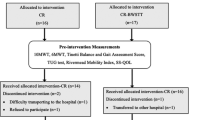Abstract
The purpose of this study was to investigate the effect of wheelchair-based rehabilitation on the physical functions, health perception, and blood lipids according to the length of time since the stroke. Wheelchair-based rehabilitation progressed for 60 min per session, five times per week for 6 weeks. Physical functions, health perception (SF-36), and blood lipids were measured before and after rehabilitation. Physical fitness for physical function such as agility, grip strength, lower-body muscular endurance, flexibility, and posture control significantly improved after 6 weeks of rehabilitation. Health perception improved significantly with physical and mental health according to time since the stroke occurred. Overall, 6 weeks of wheelchair-based rehabilitation had a positive effect on the physical function and health perception regardless of stroke duration. Wheelchair-based rehabilitation had a more positive effect on the physical functions and health perception on the patients who suffered their stroke most recently. We suggested that wheelchair-based rehabilitation is necessary even through wheelchair based for chronic stroke patients, and it was useful their improved of quality of life.
Similar content being viewed by others
References
Antiplatelet Trialist’s Collaboration (1988) Secondary prevention of vascular disease by prolonged antiplatelet treatment. Br Med J 296:320–331
Antiplatelet trialist’s collaboration (1994) Prevention of death, myocardial infarction, and stroke by prolonged antiplatelet therapy in various categories of patients. Br Med J 308:81–106
Best-Martini E, Botenhagen-DiGenova KA (2003) Exercise for frail elders. Hum Kinet
Blank GJ, Ridker PM (2002) Inflammatory bio-marker and cardiovascular risk prediction. J Intern Med 252:283–294
Campbell FM, Ashburn AM, Pickering RM, Burnett M (2001) Head and pelvic movements during a dynamic reaching task in sitting: implications for physical therapists. Arch Phys Med Rehabil 82(12):1655–1660
Dietz V, Ketelsen UP, Berger W, Quintern J (1986) Motor unit involvement inspastic paresis; relationship between leg muscle activation and histochemistry. J Neurol Sci 75(1):89–103
Edzard EA (1990) Review of stroke rehabilitation and physiotherapy. Stroke 21(7):1081–1085
Hermann N, Black SE, Lawrence J, Szekly C, Azalai JP (1991) The sunnybrook stroke study a hemiplegic Patients. J Korean Acad Nurs 21(1):50–61
Huang C, Cheng R-H, Chen S-R, Li C-I (2010) Enhancing network availability by tolerance control in multi-sink wireless sensor metworks. J Converg 1(1):15–21
Imani M, Taheri M, Naderi M (2010) Security enhaned routing protocol for ad hoc networks. J Converg 1(1):43–47
Johnsson R, Magnusson M (1991) Human postural dynamics. Ciruits Rev Biomed Eng 18(6):413–437
Koh IS, Kim HC, Kwon SB, Hwang SH, Kwon KH, Kim SM, Song HK, Lee BH (1999) The compliance of stroke patients for secondary prevention. In: Seoul and Kyunggi province. The Korean Neurological Association 17(4):472–477
Kang HJ (2007) Stroke mechanism factors and physical activity. J Nat Sci Soonchunghyang Univ 14(1):41–46
Kim KS, Kim KS, Kang JY (2001) Effects of biofeedback exercise training in hemiplegic patients after stroke. J Korean Acad Nurs 31(3):432–442
Kim JH, Han TR (2007) Rehabilitation medicine, Department of Rehabilitation Medicine Seoul National University College of Medicine
King RB (1996) Quality of life after stroke. Stroke 27:1467–1472
Kirker SG, Jenner JR, Simpson DS, Wing AM (2000) Changing patterns of postural hip muscle activity during recovery from stroke. Clinic Rehabil 14(6):618–626
Kong SA, Han SW (2008) Effects of the elastic band training on the daily living and the range of motion in chronic hemiplegia. J Adapt Phys Act 16(1):117–134
Lee SH, Kim SH, Jung MH, Kim YS (2008) The effects of music therapy on the quality of life of stroke patient. J welf Aged 41:205–234
Mol V, Baker D (1991) Activity intolerance in the geriatric stroke patient. Rehabil Nurs 16:337–343
Rubenstein LZ, Robbin AJ, Schulman BL, Rosado J, Osterweil D, Josephson KR (1988) Falls and instability in the elderly. J Am Geriatr Soc 36:266–278
Sabut SK, Sikdar C, Singh P, Kumar R, Manjunatha M (2011) A portable neuroprosthesis for applications in gait rehabilitations with stroke patients. Int J Med Eng Inform 3(2):156–166
Shah S, Vanclay F, Cooper B (1989) Improving the sensitivity of the Barthel index for stroke rehabilitation. J Clin Epidemiol 42(8):703–709
Statistics korea (2007) Death rates for condensed list of causes by sex and age
Studenski S, Duncan PW, Perera S (2005) Daily functioning and quality of life in a randomized controlled trial of therapeutic exercise for subacute stroke survivors. Stroke 36:1764–1770
Svantesson U, Takahashi H, Carlsson U, Danielsson A, Sunnerhagen KS (2000) Muscle and tendon stiffness in patients with upper motor neuron lesion following a stroke. Eur J Appl Physiol 82(4):275–279
Tanqemen PT, Banaitis DA, Williams AK (1990) Rehabilitation of chronic stroke patients: changes in functional performance. Arch Phys Med Rehabil 71(11):876–880
Wade DT, Hewer RL, Skillbeck CE, David RM (1985) Stroke: a critical approach to diagnosis, treatment, and management. Year Book Medical Publishers Inc, Chicago
Wan Thomas TH (2010) Global health research strategies. Int J Public Pol 5(2/3):104–120
Ware JE, Snow KK, Kosinski M (1993) SF-36 Health survey: manual and interpretation guide. The Health Institute, New England Medical Center, Massachusetts
Wolf SL, Winstein CJ, Miller JP, Taub E, Uswatte G, Morris D, Giuliani C, Light KE, Nichols-Larsen D (2006) Effect of constraint-induced movement therapy on upper extremity function 3–9 months after stroke: the EXCITE randomized clinical trial. J Am Med Assoc 296(17):2095–2104
Yong M, Diener HC, Kaste M, Mau J (2005) Characteristics of blood pressure profiles as predictors of long-term outcome after acute ischamic stroke. Stroke 36(12):2619–2625
Author information
Authors and Affiliations
Corresponding author
Rights and permissions
About this article
Cite this article
Choi, H.J., Kim, Y.S., Park, D.S. et al. Effects of wheelchair-based rehabilitation on the physical functions and health perception of stroke patients. Pers Ubiquit Comput 17, 1365–1372 (2013). https://doi.org/10.1007/s00779-012-0571-9
Received:
Accepted:
Published:
Issue Date:
DOI: https://doi.org/10.1007/s00779-012-0571-9



